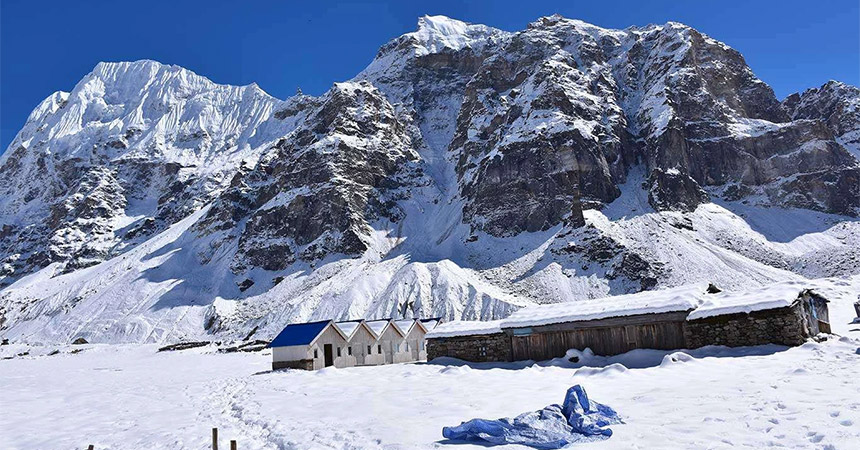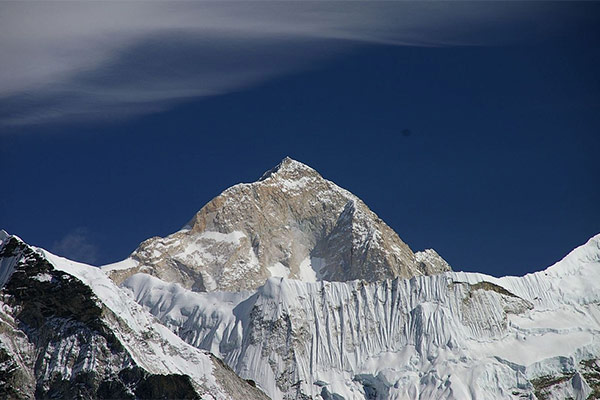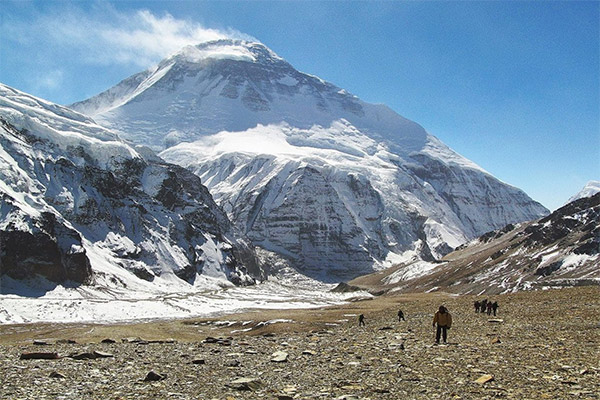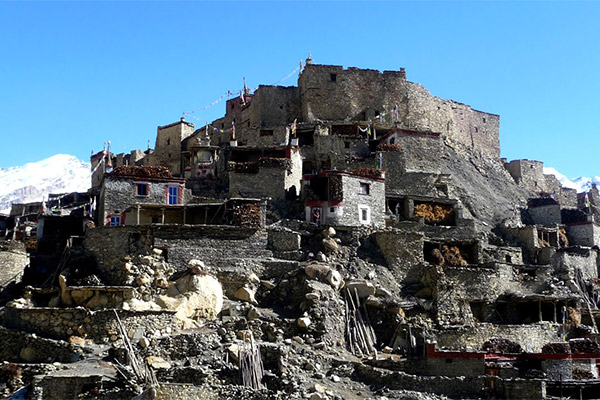
Kanchenjunga Base Camp Trek is a journey of discovery through the unspoiled beauty of the far eastern region of Nepal. Named after the mighty Mt. Kanchenjunga (8586m), the third-highest peak in the world. This trail unveils a realm of awe-inspiring mountains, diverse landscapes, and cultural experiences that capture the essence of the Himalayas. This colossal mountain, revered by locals and adventurers alike, becomes a constant companion as the trek unfolds. Passing through the Arun valley, often referred as one of Nepal’s most picturesque regions. This trail takes us through a mosaic of terraced fields, dense forests, and enchanting villages. The Kanchenjunga region is popular for towering peaks and also known for it’s cultural tapestry woven by the Sherpa, Rai, Limbu, and Gurung communities. Their unique traditions, lifestyles, and warm hospitality provide trekkers with an intimate insight into the lives of those who call these mountains home.
In fact, Kanchenjunga Base Camp Trek route was opened to trekkers in 1988. This area is protected by the Kanchenjunga Conservation Area so you need to get special permit for restricted trekking area. Therefore, the Kanchenjunga Trek beckons to those trekkers. They seek adventure, yearn to tread on paths less traveled, and want to experience the untouched beauty of the Himalayas in all its splendor.
Similarly, as we venture deeper into this remote terrain, the ecosystem transforms around us. From the lush vegetation of the lower altitudes to the alpine meadows, the variety of flora and fauna is a testament to the region’s ecological diversity. Along the path, we may encounter with Himalayan black bears, red pandas, snow leopards, and other elusive wildlife. The route itself is an odyssey through various terrains. We navigate through the verdant lowlands, cross rivers on suspension bridges and traverse glacial moraines. The negotiate rocky slopes are all while being serenaded by the grandeur of the Himalayas. The allure of Lhotse, Everest, Makalu, Kanchenjunga itself remains a constant source of inspiration, pushing us forward on our path.
Upon your arrival in Kathmandu, you will be greeted at the airport and transferred to your hotel. Later in the evening, we will have a pre-departure meeting regarding the details of your trip.
In the morning, we will pick you from your hotel and then drive to the airport for our scenic flight to Bhadrapur. After flight we then drive to the picturesque town of Ilam. Ilam is the largest tea plantation area in Nepal.
After breakfast, we will drive to Taplejung passing through terraced fields and many scenic villages that dot the landscapes. This village is mostly inhabited by Limbu People.
On this first day of our adventure, we set foot on the winding trails that will lead us through the captivating landscapes of the Kanchenjunga region. The path unfolds through the lush mid hills, traditional mud-brick houses, past rice paddies, terraced farm fields and cardamom farms. Our trail guides us forward to Mitlung along the ancient trails that generations have walked before us.
Today’s hike involves a steep climb through dense forests and high alpine meadows. Along the way, we come across Limbu and Tamang villages, such as Siwan, Tawa, and Porke. We continue along the riverbank before descending to the Thiwa River and on to Chirwa. Chirwa is a Limbu village nestled within the embrace of a Himalayan gorge. The lush greenery, dense patches of sub-tropical rainforest, and imposing cliffs create a dramatic backdrop for this picturesque village. The locals here grow rice, millet, barley, wheat, and corn.
Until Tapethok, we hike through lush green hills coated in various types of trees and vegetation, suspension bridges, and waterfalls. From here we will be entering Kanchanjunga Conservation Area so we will have our special permits checked before continuing our trek to Sukethum along Tamor River, crossing suspension bridges and passing through several villages like Temewa, Hellok and Lelep. Sukathum is the junction of the Tamur and Gunsa Khola.
Continuing our trek through the captivating landscapes of the Kanchenjunga region, we set our sights on Amjilosa. We trek along the Ghunsa Khola, making our way to Amjilosa by ascending steep terrain in open areas. The trail takes us through dense bamboo, oak and rhododendron forests. Small Sherpa villages dot the path, offering glimpses into the local way of life. The route includes yak pastures and multiple suspension bridges over the Ghunsa Khola before we arrive at Amjilosa, a charming Tibetan village.
Continuing our journey, we leave Amjilosa and begin trekking from the riverside. We navigate through a dense forest of bamboo, fir, and rhododendrons until we arrive at a small stone house near the river. Ascending uphill, we cross several small bridges, accompanied by breathtaking waterfalls originating from the mountains. Another short steep ascend and descend leads us to a Tibetan settlement, Gyabla. This leg of the trek lacks villages, creating a sense of seclusion amidst the peaceful forest environment. Amidst shaded spots, we’re treated to magnificent views of Nango Ma and the southwest side of the Kanchenjunga massif. Our journey now takes us into the realm of high mountains.
Leaving Gyabla behind, we proceed towards Phale, an old Tibetan refugee camp that houses Tashi Choding Gumba constructed by refugees who escaped the Chinese communist regime. Our trail remains relatively flat as we traverse through pine forests and occasionally cross rivers. Along the way, we encounter WWF memorial stupa erected in honor of 22 diplomats, politicians, and NGO workers from various countries who tragically lost their lives in a plane crash. Soon after, we reach our destination Ghunsa, a large Sherpa Village. Ghunsa serves as a crucial junction for trekkers heading to and from the Kangchenjunga Base Camp and the Sale La Pass.
We’ll spend the day in the village of Ghunsa, which is nearly 3,600 meters above sea level. This is a crucial step to acclimatize in higher altitudes. You have two alternatives on how to spend your day today.
Hiking is a good option if you want to get some exercise. This hike will lead you to a small ridge which offers a panoramic view of peaks such as Phole Peak and Sobithongi Peak. You’ll also get a glimpse of the majestic Mt. Khumbakaran.
We could also visit the ancient village of Ghunsa. By visiting monasteries and socializing with the inhabitants, you may immerse yourself in the local culture and Buddhist traditions. This is a once-in-a-lifetime opportunity to learn about their way of life and spirituality.
After a day of rest, recharged and ready, we resume our trek towards Khambachen. The path navigates through pine forests, juniper plants, and alongside the flowing river. Continuing past a waterfall, we approach an area prone to landslides, requiring our careful attention. Passing by villages like Rambuk Kharka and Lyakep, our ascent takes us deeper into the wilderness, far from urban life. This region is frequented by people only during specific seasons for yak grazing and potato cultivation. As we approach our destination, impressive peaks, including Kumbakarna (7711m), NyaklaLachung, and Pholesobi Thongi (6652m), emerge on the horizon.
From the Kambachem village, a breathtaking panorama unfolds, showcasing the majestic Jannu, Nagphu, and Sarphu mountain ranges, as well as Nupchu and numerous other peaks.
The day’s hike presents a bit of a challenge, as the trail winds through rocky fields decked with large boulders on the hillside. As we steadily ascend through these exposed rocky terrains, we reach Ramtang, a temporary shelter for yaks with a small stupa. From this point, the closeness of Kanchenjunga South becomes apparent, along with White web (6950m) and Mera Peak (6334m). With the altitude rising, vegetation becomes scarcer, leaving only clusters of small juniper plants. Continuing forward, we trek along the moraines of the Kanchenjunga Glacier before arriving Lhonak. More and more peaks gradually come into view: Nepal Peak (7177m), Tent Peak (7362m), Pathibhara (6838m), Pyramid Peak (7140m), among others. During the early mornings, it’s possible to spot wild blue sheep grazing in large herds.
Today marks the highly anticipated highlight of our trek. Our trek takes us across the Kanchenjunga Glacier’s moraine, gradually ascending as we make our way to the Pangpema North Base Camp at an elevation of 5,160 meters. Upon reaching the Kanchanjunga Base Camp, vibrant prayer flags greet us amidst the backdrop of the mesmerizing and awe-inspiring view of Mt. Kanchenjunga (8586m) and its neighboring snow-capped peaks that straddle the borders of Nepal-India and Nepal-Tibet. After immersing ourselves in this magnificent vista and taking time to appreciate the accomplishment, we begin our descent back to Lhonak.
After accomplishing our dream and bidding farewell to Lhonak, we retrace our way back to Ghunsa. Our descent leads us along the moraines of both the Kanchenjunga Glacier and the Kumbhakarna Glacier. During this journey, we’re treated to breathtaking views of various mountains, traverse through pine and rhododendron forests, and the enchanting waterfalls cascading through the landscape.
Our descent continues as we make our way to Amjilosa, a journey that takes us through enchanting forests, lush pastures, rolling ridges, babbling streams, and offers awe-inspiring views of the majestic snowcapped Mountains.
Today is our final day of walking. We retrace our steps back to Lelep, crossing numerous bridges over the Ghunsa Khola and passing through picturesque landscapes. As we arrive in Lelep, we bid farewell to the mountains, carrying with us the cherished memories and the refreshing mountain air. From Lelep, we take a shared jeep ride back to Taplejung, and then on to Kanyam in Ilam. Kanyam is renowned for its tea cultivation and serves as a popular tourist destination, even among domestic travelers.
After breakfast, we will drive back to Bhadrapur airport and fly back to Kathmandu. Upon arrival in Kathmandu, we will drop you at your hotel.





